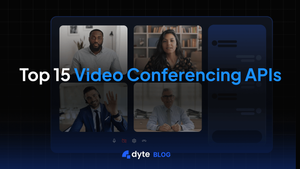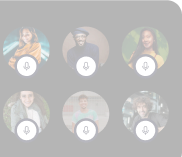Building an app that needs robust video communication features? Running your project on a strict timeline that leaves you no time to build video chat features?
Enter video conferencing APIs. You don’t have to build a single thing. Choose and purchase the right API, and you can integrate the industry-best video conferencing features into your app’s ecosystem. Depending on the API and SDK you choose, the integration process might not even be that much work.
But which API do you pick? We can’t tell you that because it depends on the very specific demands of your software system. But what we can do is start you off on some good choices. In this article, you’ll find a quick discussion on 5 exceptional video conferencing APIs favored by customers across industries.
You’ll have to narrow down the five to one, but this is where you get started with your research.
Must-Have Features in Every Video Conferencing API
- Multi-party video calls for chatting, meetings, webinars, etc.
- Screen sharing for all (or chosen) users during calls to facilitate collaboration and presentations.
- Virtual backgrounds that users can leverage to obscure their actual, physical background (often required for work-from-home situations where the actual setting may not be too professional).
- Real-time and whiteboard for further communication and collaboration between individuals and teams.
- Robust security mechanisms, especially for privacy protection. That is paramount as any software must be meticulous in protecting user and client data. Ideally, the API should be compliant with major laws and regulations like HIPAA, GDPR, and SOC2.
- Compatibility with multiple devices – mobile, desktop, tablet – and multiple OSes – Windows, macOS, Linux, etc.
- Enhanced customizability so that the video calls and UI can be altered to convey certain brand identity, or aesthetic preferences of the team using the API.
15 Best Video Conferencing APIs
Top 15 video conferencing APIs include Dyte, Twilio, Vonage, Daily, Mux, Agora, PubNub, Apphitect, Jitsi, Sinch, Zoom, Cisco Webex, Google Meet, Whereby and GoTo Meeting.
Let's evaluate the features of each of them:
- Dyte
- Twilio
- Vonage
- Daily
- Mux
- Agora
- PubNub
- Apphitect
- Jisti
- Sinch
- Zoom
- Cisco Webex
- Google Meet
- Whereby
- GotoMeeting
Dyte API
The Dyte API is ideal for setting up video conferencing capabilities for businesses and organizations. It can be customized for business meetings, virtual webinars, remote medical consults, customer support, and so much more. The API is completely customizable, with built-in features for easy scalability, integration with third-party software, real-time collaboration, dependable customer support, and more.
With Dyte, you get, by default, crystal-clear video and audio quality. High customization levels mean that devs can tailor the API to their platform’s needs with minimal work.
Dyte APIs are HTTP REST APIs and can be called from services written in any language or framework.
Scalability is also built-in since the SDK can support up to 10,000 participants. It’s also bewilderingly easy to integrate Dyte with your apps, by virtue of its open APIs and sample apps ready for immediate deployment.
Features of Dyte API
- Complete and seamless customizability
- In-built scalability for up to 10,000 participants
- Real-time collaboration, file sharing, and whiteboards
- AI-powered chat
- Interactive live streaming
- 24/7 customer support
- SOC 2 & HIPAA compliant
Curious about Dyte’s suitability for your development needs? Just talk to us, and let’s set you up with a seamless interactive experience.
Limitations of Dyte API
- Mobile SDKs are in beta, as of writing this article.
Pricing for Dyte API
You start with 10,000 free minutes…every month. If you exhaust these minutes, you pay $0.004 per user per minute, with recordings and RTMP-out available at $0.010 and $0.015 per minute, respectively.
Here’s a deep dive into Dyte’s pricing.
Twilio
The Twilio API is customizable, scalable, and reasonably flexible in its usage. It enables the creation and consistent use of 1-on-1 & group video meetings, text chats, WhatsApp messages, SMS, email, and programmable chats in real time.
Built on WebRTC signaling, Twilio supports app building on Android and iOS. It uses APIs for first-party data consumers and digital channels. Its scalable cloud infra allows for easy deployment of video chat to third-party apps. You also get flexible workflows, contextual data, and cross-channel communications.
You can use the API to query metadata about your account, phone numbers, calls, text messages, and recordings. It is also possible to initiate outbound calls and send text messages (but this may require extra dev effort).
Twilio is widely favored by enterprises of all sizes. They promise in-built technical intelligence and 360-degree infrastructure support.
Features of Twilio API
- Secure cloud storage
- Free trial credits for video groups and P2P
- Allows cloud recording
- 24-hour support via mail and chat
- APIs available for mobile and desktop apps
Limitations of Twilio API
- The UI is not super user-friendly. There is a considerable learning curve.
- Not much analytical support available.
Pricing for Twilio API
Pricing starts at $4 per 1,000 minutes. Recordings cost $0.004 per participant minute. Recording compositions costs $0.01 per composed minute, and you pay $0.00167 GB/day for storage after the first 10 GB is exhausted.
And, if you need a deeper exploration, read our detailed breakdown of Twilio’s pricing.
Twilio is sunsetting their Twilio Video, so in case you are looking for a replacement, here's a handy list of Top 15 Twilio Video alternatives.
Vonage API
Powered by WebRTC, the Vonage video conferencing API allows the building of curated video experiences for web, mobile, and desktop software. It is supports iOS, Android, and the web.
It is possible to deploy calls with no code/low code effort. Integration with the final software is relatively fast, as long as you have experienced devs doing the work.
Vonage APIs enable audio and video chats as well as customized video calling on user-facing apps. It also supports voice, SMS, and a wide range of messaging channels.
Features of Vonage API
- Support AES-128 and AES-256 encryption
- Compliant with GDPR and HIPPA
- Scalable as required
- Calls encrypted with AES-128 and AES-256
- Allows phone calls
- Allows broadcast messaging
Limitations of Vonage API
- No free trial.
Pricing for Vonage API
$0.00395/per participant/per minute.
Checkout the pricing for Vonage Video Conferencing APIs. If you are looking for a Vonage alternative we'll make it easier with this Vonage migration guide.
Daily API
Daily provides a live video call API that lets developers add live video and audio facilities to their software. Devs can add 1090p HD video calls with screen sharing for any device. It also offers different recording options, such as transcriptions.
There is a Daily Client SDK, used for building custom user interfaces by working with Daily’s APIs. Then there is Daily Prebuilt, a video chat widget you can embed into any application with some code.
Features of Daily API
- HD screen sharing, hand raising, breakout rooms, whiteboard.
- Can host interactive calls with upto 1000 participants.
- Provides logs for events and software performance metrics from each client in a session.
- Email and chat support available.
- Customizable UI.
- Auto-tuning of video calls.
Limitations of Daily API
- Not too many customization options.
- Mobile SDKs in beta.
- There have been some reports of delay in support.
- Devs have to add publish-subscribe logic as the tool cannot do so itself.
- Inadequate edge case management.
Pricing for Daily API
You get 10,000 free minutes every month. After they are exhausted, you pay $0.004/min/user for video calls, $0.00099/min/user for audio calls and $0.0012/min/user for streaming.
Checkout the list of top 10 Daily alternatives
Mux API
Mux is an API-first service that offers tools to create high-quality video streaming for development teams. It also provides robust call analytics. It provides the ability to implement self-optimizing videos with easier encoding delivery and renditions.
There are two major offerings – Mux Video and Mux Data.
Mux Video provides the API for advanced video streaming. A single APO call lets you post a video or livestream, and it will be ready to watch. Encoding, storage, and delivery are handled by the API, and analytics are provided by Mux Data for every video stream. You can use this real-time data to optimize calls further for multiple devices and connections.
Video calls implemented through the Mux API also provide an immediate on-demand version of the video after each session.
Features of Mux API
- Support for iOS, Android, and the web.
- Allows up to 100 participants in real-time video calls.
- Open APIs.
- Discounts on high volume.
Limitations of Mux API
- No built-in resources to manage mid-call interruptions.
- No plugin support.
- No prebuilt apps or UI; requires dev effort to build from scratch.
- No built-in interactive features.
Pricing for Mux API
You get a one-time $20 in credits for new sign-ups. Then, you pay $0.004/min for real-time video, $0.04/min for encoding, $0.003/min for storage, and $0.0012/min for streaming.
If you are looking for Mux alternatives, here's a comparision for Agora v/s Mux v/s Dyte.
Agora API
Agora's API allows developers to add real-time video and audio communication features to their applications so that users can leverage enabling users to participate in video conferences, webinars, live streaming, and the like. Devs can use the API to build HD video streaming, chat, whiteboard, polling screen sharing, and low-latency audio communication into apps.
Agora supports multiple platforms – web, iOS, Android, Windows, and macOS – as well as multiple languages. It is customizable and is designed to scale relatively well with regard to user load.
It also provides end-to-end encryption, token-based authentication, and security measures to protect user data and communication. You can use recording of audio-video, analytics, and monitoring mechanisms.
Features of Agora API
- Support for multiple platforms & programming languages.
- Ample developer documentation – documentation, sample code, etc.
- A global network (SD-RTN™) that is resilient to packet loss, jitter, and bad network conditions.
- Interconnectivity between mobile, web, and native apps.
- Highly customizable.
- Low latency.
- HIPAA compliant.
Limitations of Agora API
- Given its usage-based pricing model, Agora can be quite expensive at scale.
- Integration can require significant developer effort.
Pricing for Agora API
Agora’s API pricing is based on usage. What you pay depends on what video quality you want on your app, the number of meeting participants, and the duration of the video call (with said video quality).
Agora’s pricing model can be a little complicated (especially if this is your first time using a video calling API), so take a moment to look at their pricing page. You can also have a look at our detailed breakdown of Agora’s pricing model.
Check out how Agora compares to Dyte’s Video Calling APIs.
PubNub
PubNub provides APIs to build features for real-time online interactions between devices, users, and applications. These APIs allow the incorporation of live chat, notifications, streaming, video conferencing, and more.
With provisions for real-time messaging, chat, live updates, and collaborative tools, PubNub APIs are quite useful. They use a publish-subscribe model and enable presence detection (if a user is online or not). Devs can also create push notifications, stream multiple forms of data, and set up access controls.
PubNub supports various programming languages and platforms, including JavaScript, Python, Java, iOS, Android, and more.
Features of PubNub API
- Analytics and monitoring tools to track performance and usage.
- Support for multiple programming languages and platforms.
- Global network of data centers.
- Supports streaming of various data types, including text, JSON, binary data, and custom payloads.
- User authentication mechanisms.
- Can use PubNub Functions to run custom code in response to events within the PubNub network.
- Supports webhooks.
Limitations of PubNub API
- Cost can be a limiting factor.
- Users have stated that the infra could be more responsive.
- Some inadequacies in giving notices in advance of changes.
- Support function is not always real-time.
Pricing for PubNub API
The free trial allows up to 200 MAUs OR 1M total transactions per month. That Starter Plan, at $49/month, allows up to 1000 MAUs and up to 3000 transactions per MAU. If you choose the Pro plan, you will pay for what you use. (MAUs and transactions).
Apphitect API
Apphticen provides video conferencing API ideal for enterprises & SMEs. This API allows 100% customizations on call and chat functions.
Supported on WebRTC, Apphitect’s multi-platform API lets you build features like 1-on-1 video calling, group calling, video/audio conferencing, super scalability, load balancing, HD voice, video quality, etc. You can use it to build capabilities for meetings, webinars, presentations, and other virtual communication requirements.
Features of Apphitech API
- Multiple device & platform support
- Load Balancing
- Scalable servers
- Video quality adaptation in response to network conditions
- Complete customizability
- Support FOR UDP, TCP, HTTP as media transport
Limitations of Apphitect API
- Does not enable the inclusion of unlimited participants in white-label video calls.
Pricing for Apphitect API
Interested parties have to contact sales to know about Apphitect’s pricing.
Jitsi Meet API
Jitsi Meet provides an open-source API to host video meetings when it's embedded into a third-party application. It comes with most of the major features expected in such an API. By using the iFrame API, you can embed Jitsi Meet into an application with relative ease.
If you use React in your web application you can use Jitsi’s React SDK instead.
If you are an existing customer of Jitsi as a Service (JaaS), please note that JaaS uses the deployment on 8x8.vc domain, and not under meet.jit.si.
Features of Jitsi Meet API
- Open source with impressive community support.
- Relatively easy setup, thanks to its one-click installation
- User-friendly UI and setup steps.
- Uses industry standards security mechanisms to ensure that user data remains strictly confidential.
- Supports multiple clients – Mac, Windows, Linux, Android, iOS.
Limitations of Jitsi Meet API
According to Jitsi’s DevOps Guide, “Building a scalable infrastructure is not a task for beginning Jitsi Administrators. The instructions (of the guide) assume that you have installed a single node version successfully and that you are comfortable installing, configuring, and debugging Linux software.”
In other words, achieving peak scalability with Jitsi Meet might not be the easiest thing in the world.
Pricing for Jitsi Meet API
As mentioned above, Jitsi Meet is open-source and free of cost. However, if you do want to opt for a paid option, you can go for 8x8 Jitsi as a Service(JaaS). Pricing for JaaS is based on the number of monthly active users (MAU).
Check out our comparison of Jitsi vs. Agora vs. Dyte for a deep dive if you are looking for Jitsi alternatives.
Sinch API
The Sinch API and SDK lets devs build customizable video communication experiences in mobile, web, and desktop apps. It works with iOS, Android, and JavaScript and is known for high-quality video and clear voice capabilities.
The API is customizable for call performance, security, and brand identity within video and audio calls. On their website, Sinch claims to provide 100% reach, providing legal access to every mobile phone on the planet.
Features of Sinch API
- Compatibility with & support for multiple platforms.
- High-grade reliability & security.
- Custom filters & masks on video calls.
- Live streaming & broadcasting capabilities.
- Low latency video.
- SMS & MMS sending capabilities.
- Phone calls.
Limitations of Sinch API
- Users have reported that documentation & support is inadequate.
- Comes with a steep learning curve.
Pricing for Sinch API
Sinch actually features different prices for different locations (countries, continents) and functions, so it’s best to reach out to their sales team and discuss your particular requirements.
Zoom
The Zoom API is solution for video conferencing. It supports the creation of 1-on-1 and group video meetings, along with features for text chats, webinars, and real-time communication.
Features of Zoom API
- Versatile support for 1-on-1 and group video meetings
- Integration with text chats, webinars, and real-time communication
- WebRTC signaling for reliable cross-platform app development
- Cloud storage for secure data handling
- Comprehensive 24-hour support via email and chat
- Mobile and desktop app APIs for flexible workflows
Limitations of Zoom API
- Some users may find the user interface less intuitive, requiring a learning curve.
- Limited analytical support compared to other platforms.
Pricing for Zoom API
Zoom API pricing is at no additional cost in their paid plans starting at $14.99 per host per month for the Pro plan. Business and Enterprise plans are available for larger organizations with additional features.
Learn more about Zoom SDK and API pricing
Bored and sick of Zoom fatigue and in need of better video conferencing platforms - do check out Zoom alternatives.
Cisco Webex
Cisco Webex offers a range of features for seamless communication and collaboration. It provides a platform for hosting video meetings, webinars, team messaging, and file sharing.
Features of Cisco Webex API
- Secure cloud infrastructure
- Extensive support for video meetings, webinars, and team messaging
- Integration with third-party applications
- Advanced analytics and reporting capabilities
- Comprehensive support for mobile and desktop applications
Limitations of Cisco Webex API
- User interface may have a learning curve for some users
- Some users might find the interface less intuitive compared to other platforms
- Analytical support might be limited compared to other communication APIs
Pricing for Cisco Webex API
There is no information available for pricing, so it's best to get in touch with their team regarding the pricing.
Considering evolving technologies and user needs, exploring WebEx alternatives can provide new perspectives and innovations.
Google Meet
The Google Meet API offers a simple solution for video meetings, events, and webinars. It provides developers with the tools to embed Google Meet functionalities into their applications.
Features of Google Meet API
- Support for video meetings, events, and webinars
- API for creating and managing meetings
- Cross-platform compatibility for various applications
Limitations of Google Meet API
- Limited features compared to some other platforms.
Pricing for Google Meet API
- Google Meet is part of Google Workspace, formerly known as G Suite.
- Google Workspace plans start at $6 per user per month for the Business Starter plan.
- Different plans offer varying features, and there is also an Enterprise plan for larger organizations.
Google Meet is widely used, but its latency and connectivity issues can't work for modern teams - so here's a list of Google Meet alternatives.
Whereby
The Whereby API is a video conferencing solution suitable for various applications. It allows developers to embed video meetings into their websites or applications.
Features of Whereby API
- User-friendly interface for easy integration
- Embeddable video meetings for websites and applications
Limitations of Whereby API
- May lack some advanced features present in other APIs.
Pricing for Whereby API
- Whereby offers a free plan with limited features.
- Paid plans start at $9.99 per month (per user) for the Pro plan.
- There are also Business and API plans available for larger organizations and custom integrations.
Check out our comparison of Whereby vs Jitsi ans other Whereby alternatives.
GoToMeeting
The GoToMeeting platform offers APIs that facilitate virtual meetings and collaboration. It supports 1-on-1 as well as group video meetings, providing a versatile environment for real-time communication.
Features of GoToMeeting API
- Intuitive and user-friendly interface
- Robust support for virtual meetings and collaboration
- Integration with popular platforms and applications
- Cross-channel communication capabilities
- Real-time analytics for enhanced decision-making
Limitations of GoToMeeting API
- Limited support for customization compared to some other platforms
- May require additional development effort for certain advanced features
Pricing for GoToMeeting API
GoToMeeting offers two main pricing plans: Professional and Business.
• Professional: $12 per month (billed annually at $144). Up to 150 participants. Unlimited meetings.
• Business: $16 per month (billed annually at $192). Up to 250 participants. Unlimited meetings. Additional features like meeting lock, transcripts, and more.
As real-time communication progresses, people have learned that they miss out on many features when using GoTo Meeting for video conferencing purposes - so here's a list of GoTo Meeting alternatives.
A Quick Comparison for 15 Best Video Conferencing APIs
| Video conferencing API | Features | Limitations | Pricing |
| Dyte | - Customizability - Real-time collaboration, file sharing, and whiteboards - Interactive live streaming - SOC 2, HIPAA and GDPR compliant - AI-powered chat |
- Mobile SDKs are in updating continuously | Starts with 10,000 free minutes, $0.004/user/minute |
| Twilio | - Customizable, scalable, flexible | - UI not super user-friendly - Twilio Video is shutting down |
Starts at $4 per 1,000 minutes, additional costs for recording |
| Vonage | - WebRTC-powered, AES encryption, scalable | - No free trial | $0.00395/participant/minute |
| Daily | - HD video calls, screen sharing, chat support | - Mobile SDKs in beta | 10,000 free minutes, $0.004/min for video calls |
| Mux | - High-quality video streaming, analytics | - No built-in resources for mid-call interruptions | $0.004/min for real-time video, additional costs for encoding, storage, streaming |
| Agora | - Real-time video and audio communication | - Usage-based pricing can be expensive | Usage-based pricing, depends on video quality, participants, and duration |
| PubNub | - Real-time messaging, chat, notifications | - Cost can be a limiting factor | Free trial up to 200 MAUs, Paid plans start at $49/month |
| Apphitect | - Multi-platform support, video quality adaptation | - Does not enable unlimited participants in white-label calls | Contact sales for pricing |
| Jitsi Meet | - Open source, easy setup, user-friendly UI | - Building scalable infrastructure can be challenging | Free and open-source, Jitsi as a Service (JaaS) available for paid plans |
| Sinch | - Customizable, high-quality video and voice | - Inadequate documentation and support | Pricing varies, contact sales for specific requirements |
| Zoom | - Cloud storage, Good quality | - Some users find UI less intuitive | Included in Zoom's paid plans starting at $14.99/host/month |
| Cisco Webex | - Secure cloud infrastructure, extensive support | - UI may have a learning curve | Contact sales for pricing (information not available) |
| Google Meet | - Video meetings, events, webinars | - Limited features compared to some platforms | Part of Google Workspace, plans start at $6/user/month |
| Whereby | - User-friendly interface, embeddable video meetings | - May lack some advanced features | Free plan available, paid plans start at $9.99/user/month |
| GoToMeeting | - Intuitive interface, robust support | - Limited support for customization | Professional Plan: $12/month, Business Plan: $16/month |
Conclusion
Once you’re assured that a video conferencing API possesses the must-have features – Multi-party video calling, screen sharing, virtual background, real-time messaging and whiteboard, security and privacy protection, compatibility with multiple devices, customizability – you (and your dev team) has to dive down into the nitty-gritty. Which API gives you the most added advantage? Which API makes the most sense as a financial investment? Which API is the easiest to use, and lets you set up your final app as fast as possible?
Well, we can’t help you with the other APIs on this list, but we can certainly give you the resources to research Dyte to its last feature:
Interested? Let’s talk so that the Dyte API can show you exactly what it is capable of – easing your dev team’s workload without compromising on the results, ever.




